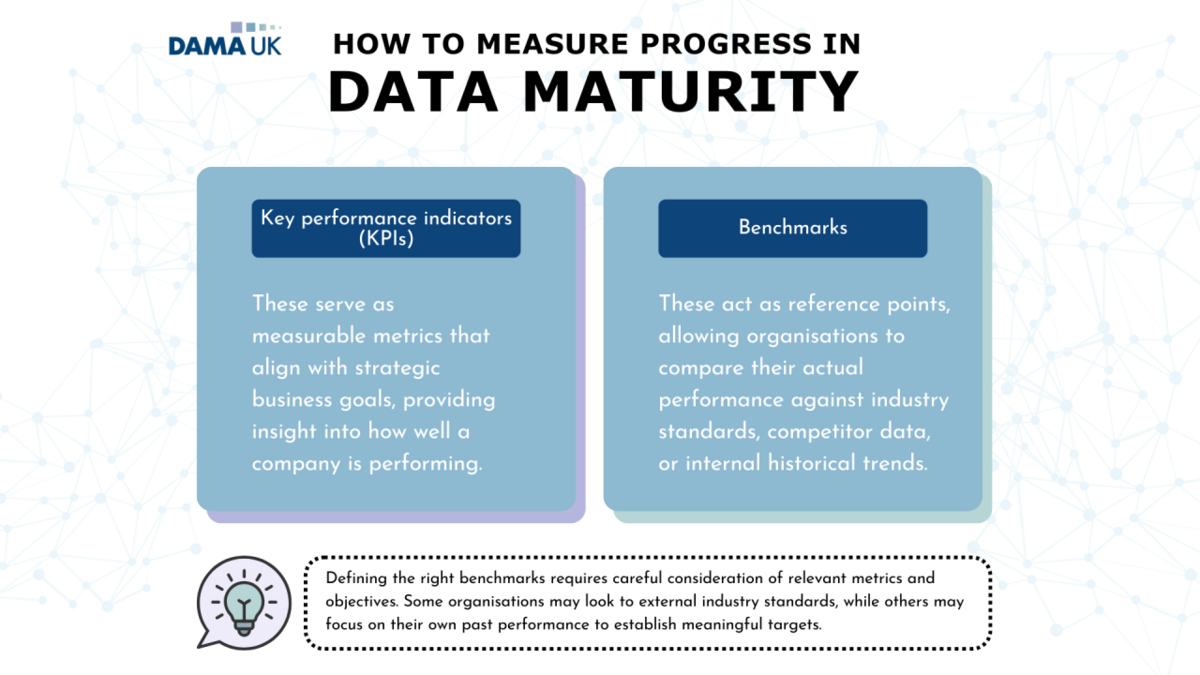
Quantifying Growth: Metrics and Benchmarks in Data Maturity
Data maturity measures the capability of organisations to manage, analyse, and apply their data appropriately and successfully, reflecting their ability to essentially turn raw data into insights that drive strategic decisions and long-term growth. For many organisations, the journey toward data maturity begins with scattered, inconsistent data use. Over time, as they recognise the potential of a structured approach, they take steps to integrate data into their operations, ensuring decisions are guided by evidence rather than intuition. This progression isn’t just about technology; it requires cultural shifts, leadership commitment, and continuous refinement.
Understanding where an organisation stands in its data maturity journey is crucial for unlocking the full potential of data. By exploring the different stages of maturity, the challenges that hinder progress, and the strategies that support advancement, businesses can make informed decisions that position them for sustained success.
Understanding Data Maturity
At its core, data maturity reflects how effectively a business uses its data to drive informed decision making. It’s not just about collecting information but about managing and analysing meaningful insights that can influence strategy and fuel growth. In the early stages of a company’s development, data maturity is often low; while data is generated, it tends to be handled in an ad hoc manner as the organisation prioritises sustainable growth. However, as businesses expand, they start to recognise data as a valuable asset and take deliberate steps to leverage it. This often involves investing in data literacy initiatives, embedding analytical tools, and fostering a culture where decisions are guided by both qualitative and quantitative insights rather than instinct or convention.
Data maturity undergoes this evolution in stages. Four stages, to be exact, with each level representing a combination of strategic, operational, and cultural data-driven practices.
Let’s take a look at each stage:
Level 1: Data-Exploring - At the first level, businesses acknowledge the need to collect data but have yet to establish clear best practices for how and when to use it. Data silos between teams create inconsistencies, and decisions are often still made based on instinct rather than insights.
Level 2: Data-Informed - As companies progress to Level 2, leadership begins to invest in analytics tools and frameworks, setting foundational best practices for data management. Teams start incorporating success metrics into their planning, and basic data training becomes more widespread, enabling them to make more structured decisions.
Level 3: Data-Driven - On reaching Level 3, there is often a significant transformation, where data is deeply embedded into the organisation’s operations and strategy. At this stage, access to accurate, reliable data is widespread, and teams use it to optimise processes, measure business impact, and inform decision making across functions.
Level 4: Transformed - Finally, at Level 4, data becomes an intrinsic part of the company’s DNA. There is alignment between teams, all working from shared dashboards and common data sources. Decision making is not only data-driven but also predictive, allowing organisations to anticipate trends and act proactively.
Why Data Maturity Matters to Organisations
Data flows through every part of a business, from marketing and sales to finance, HR, and operations. With all the technology that is available today, organisations now have the ability to extract meaningful insights from vast amounts of data in real time. This presents an incredible opportunity and, if acted on efficiently, businesses can uncover trends, predict market shifts, and make informed strategic decisions like never before. However, while the technical ability and ambition is there, many professionals, particularly in areas like marketing, struggle with data fluency.
The rapid pace of digital transformation can leave teams feeling overwhelmed, unsure how to translate raw data into actionable insights. This is where data maturity becomes essential. The more advanced an organisation’s data maturity, the more confidently it can move away from intuition-based decision making and towards strategies built on clear, measurable evidence.
Measuring Progress: Metrics and Benchmarks in Data Maturity
A high level of data maturity enables organisations to make smarter decisions, anticipate customer behaviour, and ensure compliance with governance and security standards. But how can an organisation decipher where they stand in terms of data maturity? Many businesses believe they are already data-driven, yet their processes still rely on fragmented, inaccessible, or underutilised data.
To gauge their true level of maturity, organisations should ask themselves key questions:
- How do we measure the success of digital initiatives?
- Can our teams easily access and analyse the data they need?
- Do we connect product changes to business performance?
- Are we experimenting with new ideas based on both qualitative and quantitative insights?
Answering these questions honestly is the first step in determining what’s needed to move further along the data maturity curve and unlock the full potential of data-driven growth. Next, understanding how to measure progress in data maturity is crucial for organisations striving to become more data-driven.
There are two main ways:
Key Performance Indicators (KPIs): these serve as measurable metrics that align with strategic business goals, providing insight into how well a company is performing.
Benchmarks: benchmarks, on the other hand, act as reference points, allowing
organisations to compare their actual performance against industry standards, competitor data, or internal historical trends. Defining the right benchmarks requires careful consideration of relevant industry metrics and business objectives. Some organisations may look to external industry standards, while others may focus on their own past performance to establish meaningful targets.
.png)





